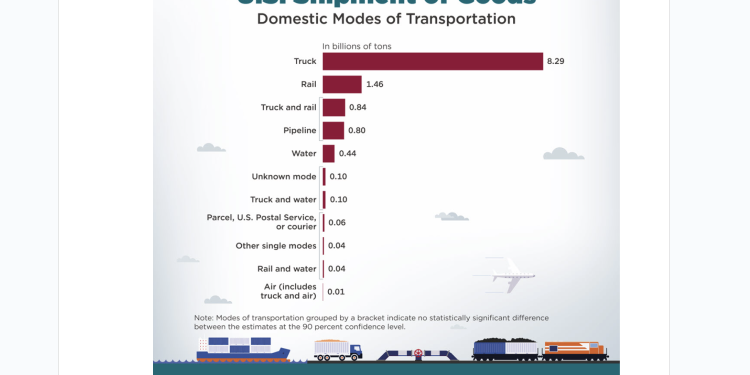June 26, 2025 — American businesses shipped a staggering 12.2 billion tons of goods worth $18.0 trillion in 2022, according to new data released by the U.S. Census Bureau. While the total weight of shipments remained virtually unchanged from 2017, the value surged by $3.5 trillion—a 24% increase that highlights the growing importance of freight transportation to the national economy.
The latest Commodity Flow Survey reveals that trucks continue to be the backbone of America’s supply chain, hauling more than two-thirds of all goods by weight and nearly three-quarters by value.
Trucks Rule the Roads
Transportation by truck dominated the freight landscape in 2022, carrying 8.3 billion tons of goods—68.1% of total tonnage—valued at $13.2 trillion. This represents 73.5% of the total value of all commodities shipped across the United States.
“The numbers underscore just how critical our trucking industry and highway infrastructure are to keeping goods moving,” said transportation analysts reviewing the data.
Regional Powerhouses Drive Growth
The South emerged as the nation’s freight shipping leader, moving 4.9 billion tons of goods worth $6.7 trillion in 2022. The Midwest followed closely, shipping 3.4 billion tons valued at $4.8 trillion.
Manufacturing facilities shipped 4.9 billion tons of commodities worth $7.1 trillion, while wholesale establishments moved 4.1 billion tons valued at $8.1 trillion.
Texas: A Major Beneficiary
While the Census Bureau report doesn’t break down state-specific data, Texas stands to benefit significantly from these national trends. As the second-largest state by both population and economy, Texas plays a crucial role in the South’s dominance in freight shipping.
The state’s strategic advantages include:
Geographic Position: Texas serves as a critical gateway between the U.S. and Mexico, with major trade corridors running through the state. The report notes that trucks carried 49.6% of tonnage traveling to Canada, suggesting similar patterns likely exist for Mexico-bound freight.
Infrastructure Network: With extensive highway systems, major ports in Houston and other coastal cities, and significant rail connections, Texas is well-positioned to handle the continued growth in freight movement.
Energy Sector Impact: The report indicates that hazardous material shipments—which include petroleum products—weighed 2.6 billion tons and were valued at $2.1 trillion in 2022. As a major energy-producing state, Texas likely accounts for a substantial portion of these shipments.
Economic Diversification: Texas’s mix of manufacturing, agriculture, and energy production aligns well with the sectors driving freight growth nationally.
Short-Distance Shipping Dominates
An interesting finding from the survey shows that 56.4% of all freight tonnage traveled less than 50 miles in 2022. This trend toward local and regional shipping could benefit Texas’s major metropolitan areas and industrial centers.
New Category Emerges
The 2022 survey introduced a new category called “Customer Pickup,” which accounted for 1.4 billion tons of goods (11.4% of total tonnage) valued at $1.0 trillion. This category reflects changing consumer behavior and the growth of e-commerce, trends that are reshaping freight patterns across Texas and the nation.
Looking Ahead
The Commodity Flow Survey, conducted every five years since 1997, provides crucial data for transportation planners and policymakers. The findings help guide decisions about infrastructure investments, safety regulations, and environmental policies.
For Texas, the data suggests continued opportunities in freight transportation, logistics, and related industries. The state’s position as a major shipping hub, combined with national trends toward truck transportation and regional freight movement, positions Texas well for future growth in the transportation sector.
About the Survey
The Commodity Flow Survey is conducted jointly by the U.S. Census Bureau and the Department of Transportation’s Bureau of Transportation Statistics. The 2022 survey sampled approximately 165,000 establishments across various industries, though it excludes farms, most retail establishments, and certain service industries.
All dollar figures in the report are expressed in current dollars and are not adjusted for inflation. The survey provides essential data for understanding America’s freight transportation system and planning for future infrastructure needs.




